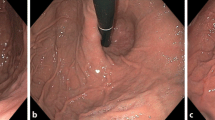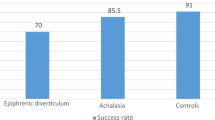Abstract
Background
To investigate the relationship between endoscopic and esophageal manometric hiatus hernia (HH).
Methods
Forty-six gastroesophageal reflux disease patients with endoscopic HH under maintenance therapy were recruited. Endoscopy was performed on all patients in a fully conscious state. Endoscopic HH was defined as apparent separation greater than 1 cm of the lower margin of the esophageal palisade vessels and the diaphragm hiatus on endoscopy under deep inspiration. Esophageal manometry was conducted using high-resolution manometry (HRM). The length between the lower margin of the lower esophageal sphincter and pulmonary inversion point was measured 10 times. The mean and maximum of the length was then calculated.
Results
The mean HH length on HRM was 0 cm (0–0) [median (25th to 75th percentile)], 0 cm (0-0), 0.5 cm (0–1.1), and 2.2 cm (1.3–2.5) in the groups with endoscopic HH lengths of 1–2, 2–3, 3–4, and 4–5 cm, respectively. The maximum HH length on HRM was 0 cm (0–0), 0 cm (0–0), 0.8 cm (0–1.4), and 2.4 cm (1.5–2.9) in the 1–2, 2–3, 3–4, and 4–5 cm endoscopic HH groups, respectively. The mean and maximum HH lengths increased significantly in the group with an endoscopic HH length of 4–5 cm compared with the other groups, but did not differ significantly among the 1–2, 2–3, and 3–4 cm groups. Of patients with endoscopic HH less than 3 cm, few had esophageal manometric HH greater than 2 cm.
Conclusions
Endoscopic diagnosis of HH under deep inspiration is not consistent with esophageal manometric diagnosis, leading to overdiagnosis.






Similar content being viewed by others
References
Iwakiri K, Kinoshita Y, Habu Y, et al. Evidence-based clinical practice guidelines for gastroesophageal reflux disease 2015. J Gastroenterol. 2016;51:751–67.
Sontag SJ, Schnell TG, Miller TQ, et al. The importance of hiatal hernia in reflux esophagitis compared with lower esophageal sphincter pressure or smoking. J Clin Gastroenterol. 1991;13:628–43.
Mishima I, Adachi K, Arima N, et al. Prevalence of endoscopically negative and positive gastroesophageal reflux disease in the Japanese. Scand J Gastroenterol. 2005;40:1005–9.
Jones MP, Sloan SS, Jovanovic B, et al. Impaired egress rather than increased access: an important independent predictor of erosive oesophagitis. Neurogastroenterol Motil. 2002;14:625–31.
Johnson LF, Demeester TR. Twenty-four-hour pH monitoring of the distal esophagus. A quantitative measure of gastroesophageal reflux. Am J Gastroenterol. 1974;62:325–32.
Iwakiri K, Hayashi Y, Kotoyori M, et al. Transient lower esophageal sphincter relaxations (TLESRs) are the major mechanism of gastroesophageal reflux but are not the cause of reflux disease. Dig Dis Sci. 2005;50:1072–7.
Iwakiri K, Tanaka Y, Hayashi Y, et al. Association between reflux esophagitis and/or hiatus hernia and gastric mucosal atrophy level in Japan. J Gastroenterol Hepatol. 2007;22:2212–6.
Hoshihara Y, Kogure T. What are longitudinal vessels? Endoscopic observation and clinical significance of longitudinal vessels in the lower esophagus. Esophagus. 2006;3:145–50.
Makuuchi H. Clinical study of esophageal hiatal hernia—diagnostic criteria and degree classification of hiatal hernia. Nihon Shokakibyou Gakkai Zasshi. 1982;79:1557–67.
Bredenoord AJ, Weusten BL, Carmagnola S, et al. Double-peaked high-pressure zone at the esophagogastric junction in controls and in patients with a hiatal hernia: a study using high-resolution manometry. Dig Dis Sci. 2004;49:1128–35.
Bredenoord AJ, Weusten BL, Timmer R, et al. Intermittent spatial separation of diaphragm and lower esophageal sphincter favors acidic and weakly acidic reflux. Gastroenterology. 2006;130:334–40.
Iwakiri K, Hoshino S, Kawami N. Mechanisms underlying excessive esophageal acid exposure in patients with gastroesophageal reflux disease. Esophagus. 2017;14:221–8.
Hayashi Y, Iwakiri K, Kotoyori M, et al. Mechanisms of acid gastroesophageal reflux in the Japanese population. Dig Dis Sci. 2008;53:1–6.
Iwakiri K, Kawami N, Sano H, et al. Mechanisms of excessive esophageal acid exposure in patients with reflux esophagitis. Dig Dis Sci. 2009;54:1686–92.
Sano H, Iwakiri K, Kawami N, et al. Mechanisms of acid reflux and how refluxed Acid extends proximally in patients with non-erosive reflux disease. Digestion. 2014;90(108–15):8.
Fletcher J, Wirz A, Young J, et al. Unbuffered highly acidic gastric juice exists at the gastroesophageal junction after a meal. Gastroenterology. 2001;121:775–83.
Kahrilas PJ, McColl K, Fox M, et al. The acid pocket: a target for treatment in reflux disease? Am J Gastroenterol. 2013;108:1058–64.
Beaumont H, Bennink RJ, de Jong J, et al. The position of the acid pocket as a major risk factor for acidic reflux in healthy subjects and patients with GORD. Gut. 2010;59:441–51.
Acknowledgements
We would like to thank Dr. Yoshio Hoshihara for his helpful advice on our manuscript.
Author information
Authors and Affiliations
Corresponding author
Ethics declarations
Conflict of interest
The authors declare that they have no conflict of interest.
Rights and permissions
About this article
Cite this article
Hanada, Y., Hoshino, S., Hoshikawa, Y. et al. Endoscopic diagnosis of hiatus hernia under deep inspiration is not consistent with esophageal manometric diagnosis. J Gastroenterol 53, 712–717 (2018). https://doi.org/10.1007/s00535-017-1403-5
Received:
Accepted:
Published:
Issue Date:
DOI: https://doi.org/10.1007/s00535-017-1403-5




